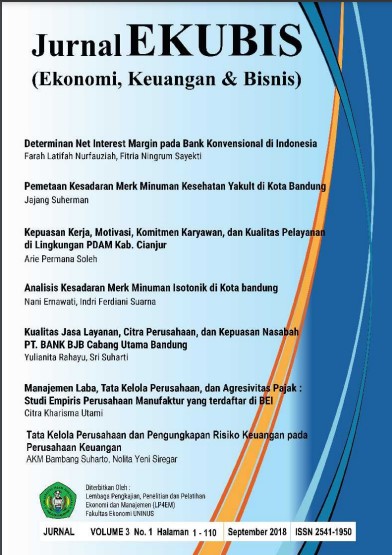PEMETAAN KESADARAN MEREK MINUMAN KESEHATAN YAKULT DI KOTA BANDUNG
Abstract
It has long been held that one of the major of marketing is to generate and maintain brand awareness, this is seen as particulary important in low-involvement situation where consumers may engage in little active search for information to aid choice. This study presents a global picture of the brand awareness dimensions and how they interact within the context of Yakult brands in Bandung City. A total of 431 respondents were selected by a systematic random sampling method. The findings conclude that, the Yakult brand awareness is categorized as relatively high. However, the Yakult should concentrate their efforts primarily on perceived quality and brand loyalty, which have high importance and directly in the construct of brand equityReferences
Aaker, D. (1991). Managing Brand Equity. New
York: Free Press.
Aaker, D. (1996). Measuring brand equity across
products and markets. California
Managing Reviews, 38(3).
Aaker, D. A. (1996). Measuring Brand Equity
Across Products and Markets. New
York, NY: Free Press.
American Marketing Association. (n.d.).
American Marketing Association.
Retrieved June 2017, from
https://www.ama.org/academics/Pages/
Model-Predictive-MeasurementsAdvertising-Effectiveness.aspx
Amstrong, G., & Kotler, P. (2015). Marketing:
An introduction (12 ed.). Edinburgh
Gate: Pearson.
Anselmsson, J., Johansson, U., & Persson, N.
(2007). Understanding Price Premium
for Grocery products: A conceptual
model of customer-based brand equity.
Journal of Product & Brand
Management, 16(6), 401-414.
ABoulding, W., Kalra, A., Staelin, R., &
Zeithaml, V. A. (1993). A Dynamic
Process Model of Service Quality: From
Expectations to Behavioral Intentions. ,
(1), 7. Journal of Marketing Research,
(1), 7-27.
Cekindo. (2016). http://www.cekindo.com/.
Cooper, D. R., & Schindler, P. S. (2014).
Business Research Methods (Twelfth
ed.). New York: The McGraw-Hill
Companies, Inc.
Creswell, J. W. (2014). Research Design:
Qualitative, Quantitative, & Mixed
Methods Approaches (4th ed.). London:
Sage Publications, Ltd.
Foster, S. (2018, Pebruari 13). Marketing IQ.
Retrieved Desember 04, 2018, from
marketingiq.co.uk:
https://www.marketingiq.co.uk/understa
nding-brand-awareness-considerationand-preference/
Hawkins, D. I., & Mothersbaugh, D. L. (2010).
Consumer behavior: building marketing
strategy. New York: McGrawHill/Irwin.
J.Kacen, J., & Lee, J. A. (2002). The influence of
culture on consumer impulsive buying
behavior. Journal of Consumer
Psychology, 12(2), 163-176.
Jacob, J., & Chestnut, R. W. (1978). Brand
Loyalty, Measurement and Management.
Journal of Advertising, 8(2).
Jurnalis. (2017, Oktober Rabu). Jumlah Remaja
Indonesia 66,3 Juta Jiwa, Kekuatan atau
Kelemahan? Laporan Reportase.
Okezone.com.
Kardes, F. R., Conrey, M. L., & Cline, T. W.
(2011). Consumer behavior. Mason,
USA: South-Western Cingage Learning.
Keller, K. L. (2002). Strategic brand
management: Building, measuring and
managing brand equity (2nd ed.). Upper
Saddle River, NJ: Pearson Education.
Keller, K. L. (2002). Strategic brand
management: Building, measuring and
managing brand equity (2nd ed.). Upper
Saddle River, NJ: Pearson Education.
Keller, K. L. (2013). Strategic brand
management: Building, measuring, and
managing brand equity (4 ed.). Harlow:
Pearson.
Kimpakorn, N., & Tocquer, G. (2010). Service
brand equity and employee brand
commitment. Journal of Services
Marketing, 24(5), 378-388.
Kotler, P., & Keller, K. L. (2016). A framework
for marketing management. Edirnbugh
Gate, England: Pearson Education.
Kotler, P., & Pfoertsch, W. (2010). Ingredient
branding: Making the invisible visible.
London: Springer Heidelberg Dordrecht.
Kotler, P., Amstrong, G., Sander, J., & Wong, V.
(2005). Principle of marketing (4th ed.).
European Edition: Prentice Hall.
Kurtz, D. L. (2008). Contemporary marketing
(13rd ed.). South-Western: Cengage
Learning.
Lemon, K. N., Rust, R. T., & Zeithaml, V. A.
(2001). What Drives Customer Equity?
Marketing Management, 20-25.
Lincoln, Y. S., & Guba, E. G. (2013). The
Constructivist Credo. Walnut Creek:
Left Coast Press, Inc.
Merriam, S. B., & Tisdell, E. J. (2016).
QUALITATIVE RESEARCH: A Guide to
Design and Implementation (fourth ed.).
San Francisco: Jossey-Bass.
Midori. (2015, Juni 16). beautynesia. Retrieved
17, 2018, from http://beautynesia.id:
Mönks, F. J., Knoers, A., & Haditono, S. R.
(2001). Psikologi Perkembangan:
Pengantar Dalam Berbagai Bagiannya .
Yogyakarta: Gajah Mada University
Press.
Mowen, J. C., & Minor, M. (2002). Perilaku
konsumen (Edisi 5 ed., Vol. 1). Jakarta:
Erlangga.
Neuman, W. L. (2014). Social Research
Methods: Qualitative and Quantitative
Approaches (7th ed.). Harlow: Pearson
Education Limited.
Osenton, T. (2002). Customer share marketing.
New Jersey: Prentice Hall.
Oskamp, S., & Schultzs, P. W. (2004). Attitudes
and opinions (3rd ed.). New York:
Lawrence Erlbaum Associate, Inc.
Peter, J. P., & Olson, J. C. (2010). Consumer
behavior and marketing strategy (9th
ed.). New York: The McGraw-Hill
Companies, Inc.
Schiffman, L. G., Kanuk, L. L., & Hansen, H.
(2012). Consumer behavior: An
European outlook (2nd ed.). England:
Pearson Education Limited.
Solomon, M., Bamossy, G., Askegaard, S., &
Hogg, M. K. (2006). Consumer
behavior: A European Perspective (3rd
ed.). Harlow: Pearson Education
Limited.
US Commercial Service. (2016). Asia Personal
Care & Cosmetics Market Guide 2016.
US Department of Commerce.
Van Osselaer, S. M., & Alba, J. W. (2000).
Consumer learning and brand equity.
Journal of Consumer Research, 27(1), 1-
Washburn, J. H., & Plank, R. E. (2002).
Measuring brand equity: An evaluation
of a consumer-based brand equity scale.
Journal of Marketing Theory and
Practice, 101(1), 46-62.
White, I. R., & Groot, A. C. (2001). Textbook of
Contact Dermatitis. Heidelberg, Berlin:
Springer.
Wood, L. (2000). Brands and brand equity:
Definition and management.
Management Decision, 38(9), 662-669.
Yakult. (2019). Company Profile 2018-2019.
Laporan.

